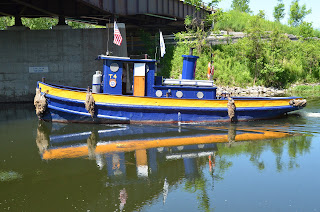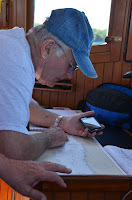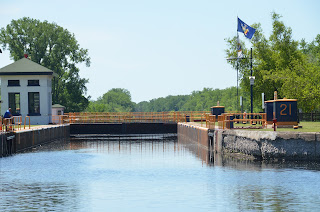We never saw locks, buildings, barges, or tugs without fresh coats of paint. The scheme: always blue and gold. And the attention to detail was impressive.

We wondered about this phoenomenon. How can the New York State Canal Commission afford this beautiful facade? We don't offer an answer or even venture a guess.

The grounds at every lock were well-manicured; every lock tender very cordial. Today, transport on the canals would be far too slow; and so they now exist for recreation: on both land and water. The light traffic affords the lock tenders a lot of time to paint and mow.
 From the Hudson River, at tide-water level, we rose 420 feet in 20 locks. Today, this portion of the canal is the Mohawk River. It is the enlarged canal which was built and rerouted a hundred years ago, once engine-powered vessels were developed.
From the Hudson River, at tide-water level, we rose 420 feet in 20 locks. Today, this portion of the canal is the Mohawk River. It is the enlarged canal which was built and rerouted a hundred years ago, once engine-powered vessels were developed.In Rome, NY we began our descent.

Occasionally, the captain helped with the ropes so that the first mate could take pictures with both hands!
Lock 23 was our personal favorite for beautification and tranquility. In most cases, you can tie up close to the lock, so we decided to have a picnic.
Here's a mixed message - or over-the-top effort. Read the sign and note what's sitting next to it! You can't fault them for caring.
 The canal leaves the Mohawk River in Rome, and the waterway soon narrows. An approaching barge is always an attention-grabber for the captain.
The canal leaves the Mohawk River in Rome, and the waterway soon narrows. An approaching barge is always an attention-grabber for the captain. The Erie Canal opened in 1825. Governor DeWitt Clinton headed the first fleet on a boat called "Seneca Chief." They traveled from Buffalo to New York City, and carried two barrels of water from Lake Erie. Upon reaching New York, they were emptied into the Atlantic Ocean in a ceremony called "The Marriage of the Waters".
The Erie Canal opened in 1825. Governor DeWitt Clinton headed the first fleet on a boat called "Seneca Chief." They traveled from Buffalo to New York City, and carried two barrels of water from Lake Erie. Upon reaching New York, they were emptied into the Atlantic Ocean in a ceremony called "The Marriage of the Waters". In 1995, William Least Heat-Moon carried water from the Atlantic Ocean to the Pacific in a 5000 mile journey across America, almost entirely by boat. What was even more
amazing was his choice of craft, a C-Dory. Not very big, but probably a
good choice for the waterways he would navigate. The trip marked "a first", and he recounted it in a book entitled "River-Horse: A Voyage Across America." It looks like the adventure inspired many others, as we passed these two expedition-outfitted C-Dorys.
In 1995, William Least Heat-Moon carried water from the Atlantic Ocean to the Pacific in a 5000 mile journey across America, almost entirely by boat. What was even more
amazing was his choice of craft, a C-Dory. Not very big, but probably a
good choice for the waterways he would navigate. The trip marked "a first", and he recounted it in a book entitled "River-Horse: A Voyage Across America." It looks like the adventure inspired many others, as we passed these two expedition-outfitted C-Dorys. West of Rome, it felt more like we were in a real canal, but not the original, which was 40 feet wide and 4 feet deep. When it was enlarged it was renamed the "Barge Canal".
West of Rome, it felt more like we were in a real canal, but not the original, which was 40 feet wide and 4 feet deep. When it was enlarged it was renamed the "Barge Canal". Suddenly, the canal dropped us into Lake Oneida, east of Syracuse. The twenty mile crossing is an official portion of the canal. But the lake is by no means a time to disregard the Chart Plotter. There are many shallows and rocks, requiring a marked channel, although the buoys are not nearly as abundant.
Since we entered the Erie in Waterford, Allan noticed that our GPS indicated our position was 50-100 feet "off" to the right; many times it showed we were moving ahead on land. This wasn't of much concern until the lake.


The good old paper chart came in handy (always good to carry back-ups) and Paul helped chart the course.
Once we reached the other side, Allan called Garmin and cited our position. They plugged it in and confirmed that indeed, there was a software problem. A few days later we received an email saying that NOAA has not produced detailed charts and so ... That's as good as it's gonna get.
A few miles after exiting the lake we came to an important sign marking the junction of the Oswego and Erie Canals. Obviously, this couldn't have been an official sign because it wasn't blue and gold. But we believed it anyway and turned right, or north.
The point in the journey was a photo op, but after 48 years of marriage, couples don't always see things in the same light.
We headed to the first lock on the Oswego Canal to stop for the night and to meet an LNVT wannabe who had been following our blog.

He arrived with a load of local food products to welcome us to the region.
It would have been a shame not to sample the fare, so we ditched dinner plans and grilled up the dogs.

The highlight of the larder was local wine. It couldn't have been more appropriate.

The next day, with "most" of the wine out of our systems, we tackled the seven locks on the Oswego Canal. The first one brought a slight surprise, a different method of "hanging on." We had become accustomed to holding onto ropes. This lock had a pole around which we looped our lines.

All locks were descending. Even though this canal is only 24 miles long, there is a lot of change between the first lock at the little village of Phoenix and lock 8 in Oswego.
Locking adventures are not exclusive to the Erie. With a little wind and no bow thruster it can sometimes be tricky to get one's boat parallel with the lock wall. Note the boat hook sticking out of the boat on the right. Semper Paratus!
Lock 8 with Lake Ontario ahead and the end of this leg. We've left Sally W to come home for two days to see the family. We will return tomorrow and cast off on Friday. Next adventure: The Thousand Islands.






















i think the more accurate statement is "after 4... years of marriage, you intuitively complement each other . . "
ReplyDelete